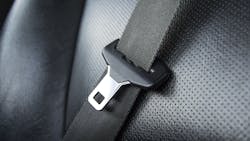When Montgomery County, Maryland Assistant Police Chief Thomas Didone, now retired, narrated a “MythBusters” style video on seat belts a few years ago, he says that a lot of the myths that were debunked several decades earlier had since resurfaced.
“I remember us working on this issue in the 90s and that’s back before many agencies had a policy that was written to ensure that seat belt use was mandatory. We went through this with the law enforcement executives back then and we thought we had the problem solved when we wrote the policy,” he says, noting that there is now a new generation.
Diadone spoke during a webinar focused on traffic safety presented by the National Law Enforcement Officers Memorial Fund in partnership with the National Highway Traffic Safety Administration (NHTSA).
This article appeared in the July issue of OFFICER Magazine. Click Here to view the digital edition. Click Here to subscribe to OFFICER Magazine.
Put to the test
The Maryland Highway Safety Office contracted with a commercial video company to create the video that was filmed at the Maryland Police and Correctional Training Center.
Officers had complained that they wouldn’t wear their seat belts because they slowed them down when they were trying to bail out and pursue a suspect or that they worried if they got caught in an ambush, they would be trapped.
In the first part of the video to examine the myth that a seat belt will slow the exit from a vehicle, an officer with the Maryland Transportation Authority conducted four traffic stops when he was unbelted and was tracked for how long it took him to exit the vehicle. The officer logged an average time of 2.79 seconds. This was done on four traffic stops again, this time he was belted. The average exit time was 2.83 seconds, showing that there is little to no difference when an officer is wearing a seat belt or not wearing a seat belt when it comes to getting out of a vehicle.
“In fact, one of those traffic stops where he was belted, he got out of the vehicle in 2.75 seconds, which was faster than being unbelted,” he says. “It proved to us that the more you practice this, the better you got. We felt very comfortable that this myth was debunked.”
In the second part of the video, to examine the myth that a seat belt will impair defense from an ambush attack, another officer was tasked with driving a patrol vehicle into a simulated scenario, but this time displayed how approaching a possible ambush situation is more about creating time and distance and less about how quickly officers can exit their patrol vehicles.
“We realized that any time in a tactical situation, that you are approaching an ambush situation, 2.79 seconds or that anything close to that was too long for you to survive this event,” he says.
“The person is waiting with you with a gun, it takes them less than a second, or no more than two, to shoot the officer. So, what we wanted to teach in this environment is if you get in the ambush situation, you need to either rapidly accelerate through the situation, or back up away from the situation. In both of those situations, a seat belt is absolutely critical for you to stay in control of this vehicle.”
A reason for alarm
Between 2015 and 2019, 47% of officers involved in fatal crashes were not wearing a seat belt and 52% of officers involved in single-vehicle crashes weren’t wearing one.
For Diadone, the issue became even more personal on April 4 2010, when Montgomery County Police Officer Hector Ayala, who was on the midnight shift, was responding to a Code 3 emergency call. The cause of the crash was cited as low tire pressure, but his death was attributed to the fact he wasn’t wearing a seat belt. “During the investigation we identified the fact that the entire midnight shift was of this belief that they couldn’t wear their seat belts if they wanted to do their jobs,” he says. “That was an eye-opening experience for us and through the committee discussions with other law enforcement agencies throughout the state and the Highway Safety Committee, we found out that this was in fact something we had to address and that’s why we thought the educational program was so important to do.”
Solutions
Possible solutions for law enforcement agencies when it comes to getting officers belted include a mandatory seat belt policy with enforcement by supervisors and messaging and signage to re-enforce the policy including “buckle up” stickers placed on all patrol cars.
Diadone recommends agencies conduct their own seat belt surveys. Following Ayala’s death in 2010, the Montgomery County Police Department had interns and explorers stand in parking lots groups at every precinct station on different days to monitor officers driving away and counting the number of officers wearing seat belts.
“We didn’t announce it until after the results were calculated and they were astounding,” he says, noting only 27% were wearing seat belts. “Just telling officers to wear it and holding them accountable, in some cases, doesn’t happen.”
Another recommendation Diadone suggests is for agencies to work with the police academy or training commission to incorporate seat belt usage into training scenarios. “When you have training scenarios, make them involve a car and make them get out of their car.”
He says that the more officers train with seatbelts, the more it will become commonplace and normal for them to wear their seat belts and, more importantly, they will build the confidence they can get out of the situation and prove that they can wear the seat belt and still do their jobs.
Watch the full NLEOMF/NHTSA webinar at Officer.com/21271380
This article appeared in the July issue of OFFICER Magazine.
About the Author
Paul Peluso
Editor
Paul Peluso is the Managing Editor of OFFICER Magazine and has been with the Officer Media Group since 2006. He began as an Associate Editor, writing and editing content for Officer.com. Previously, Paul worked as a reporter for several newspapers in the suburbs of Baltimore, MD.

